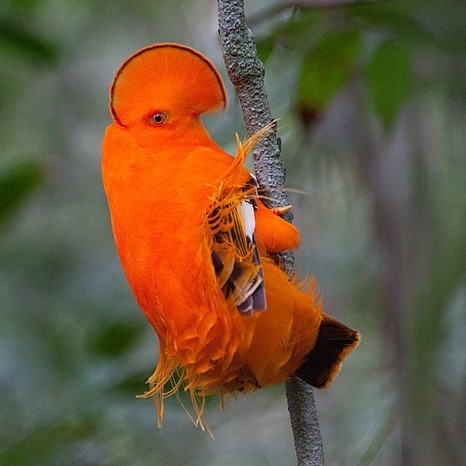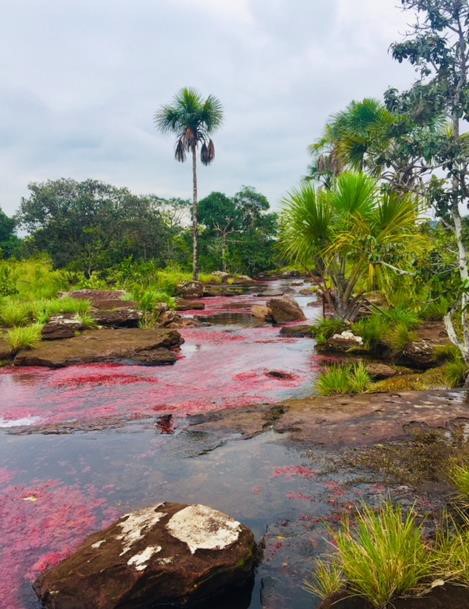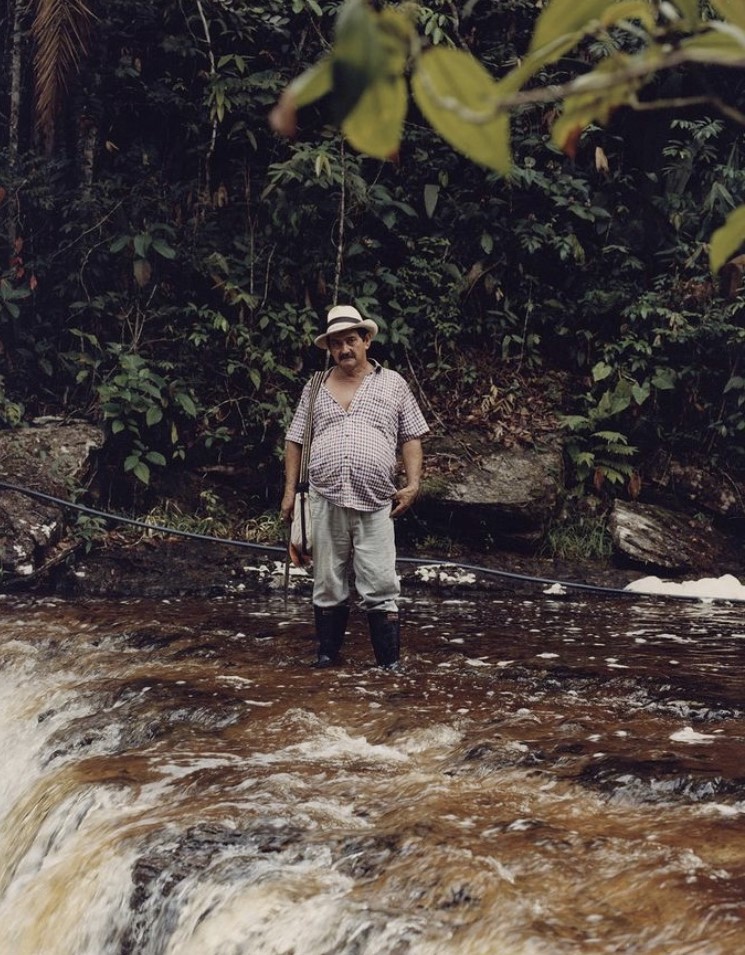by Andrés Felipe Gómez González

Well, not only the bird. A pink river, mysterious parietal paintings, and bizarre rock formations may also hold the key towards establishing peace in one of the most conflict-ridden areas of Colombia. In recent years, the people of northern Guaviare – ‘the door’ to the Amazon jungle in Southern Colombia – realised that these treasures, hidden deep in the jungle, can provide a better living than growing coca. However, this story is not just about a group of farmers turning their back on violence-fuelling illicit trade to embrace an alternative source of income; it is also a story of how to re-imagine a territory. Small-scale solutions lead the way to peaceful coexistence in conflict-affected areas.
The drug trade continues as one of the main sources of funding of the illegal armed groups in Colombia. Some regions have even seen an increase in production after the demobilisation of the Fuerzas Armadas Revolucionarias de Colombia (FARC)—Colombia’s biggest guerrilla group and the subsequent emergence of fragmented armed groups led by ex FARC warlords. This trend reinforces the idea that Colombia has fallen into what Collier & Sambanis coined as the ´conflict trap´ in their article ‘Understanding Civil War: A New Agenda’ (2002), a situation in which war tends to prolong itself by aggravating the political and economic conditions that caused the war. But Guaviare -once Colombia’s main coca producer region- tells a different story as the hectares with coca continues to drop and its inhabitants leave violence behind. Why is this happening? Although this article cannot cover all the possible explanations, it focuses on the lessons that the story of these farmers provides to policymakers looking at how to break the ‘conflict trap’ in other cases.
A window of opportunity in a land of trouble
Originally inhabited by the pre-Columbian Nukak indigenous group, Guaviare was one of the regions colonised during the Amazon rubber boom of the 1910s and 1940s. Many families migrated from the centre of the country, seeking fast revenue and adventure. Nevertheless, the ‘rubber fever’ ended quickly, leaving the new inhabitants of Guaviare alone in an immense rainforest difficult to conquer. A new era of colonisation came in the late XX Century with the boom of cocaine. The population of Guaviare grew exponentially as colonisers migrated from other impoverished regions attracted by the coca revenues. Following the new wave of colonisers, this territory started growing almost thirty thousand hectares of coca per year.

Without the strong presence of the State, the region fell into the hands of drug traffickers and the FARC guerrilla group. Under their presence, growing coca was not only about earning revenue but also a matter of survival. Those who refused to risked being hunted down by the new rulers of the territory. New generations grew up having to choose between growing coca – like their parents – or joining the FARC. According to Colombia’s Victims Unit, the conflict in Guaviare has had more than 93,000 victims since 1985, with more than 83,000 displaced and 6,612 dead. In just a couple of decades, the region had fallen into what Collier & Sambanis call the ´conflict trap´ as the political and economic outcomes of the conflict were aggravating it.

Several government-led efforts to break the relationship between coca and the communities failed, as forced eradication carried out by the Army caused serious collateral damage and aerial aspersion of glyphosate was suspended by a judicial order due to the potential risk on the health of the inhabitants. Additionally, the geographical location of Guaviare imposed legal, environmental, and economic restraints on the viability of other crops to replace coca. None of these crops could match the level of profit that coca provided. The introduction of cattle to the region has reduced the farmers’ dependence on coca by generating a decent source of income, but deforestation has caused more droughts and a loss of biodiversity that now threatens the stable income flow of the cattle-ranchers.
Fortunately, the signing of the peace treaty with FARC in 2016 opened new opportunities for Guaviare. The demobilisation of more than five hundred guerrilla fighters, as well as the government’s initiatives for the collective elaboration of local development plans, momentarily allowed the people of Guaviare to re-think their territory in ways they have not done before. Suddenly, the lush jungles that for decades hid the laboratories that produced cocaine, were seen as potential ecotourist attractions. Guaviare, which had been tagged as a ‘no go red zone,’ was now attracting birdwatchers, in the search of the Rupicola rupicola (the bird pictured above), and backpackers. Between 2016 and 2019, the arrival of passengers to the airport in Guaviare increased by 247%; and some of the operators of the main tourist attractions reported that the number of visitors had grown by at least ten times over the past few years.
However, not all guerrillas demobilised, and at least 150 men remained in arms in Guaviare when the rest of the FARC demobilised and regrouped into one of the so-called ‘dissident groups’. Since then, they have expanded their control over more territory in the area and continue to traffic drugs. However, while cocaine production has increased in other Colombian regions under the control of other dissident groups and criminal organisations, the data from Guaviare offers a more optimistic vision as hectares with coca have dropped some fifty-four per cent between 2016 and 2019. This is where this little bird comes into play.
Re-thinking the jungle and the communities
Transitioning from coca to ecotourism has involved a deep paradigm shift for the communities in Guaviare. Most of the inhabitants saw the rainforest as an obstacle to progress, and thousands of hectares were chopped down to plant coca or to introduce cattle. But now, local leaders in Guaviare -particularly in the area of the ´Serranía de la Lindosa´- have taken action to promote more sustainable exploitation of the forests that were once under the control of the FARC. Former coca farmers from communities surrounding the emerging touristic hotspots have created cooperative associations and turned themselves into tourist guides. Their services include taking the tourists to look for the bird, to see the cave paintings, and to take a dip in the river where the plant Macarenia clavigera dyes the water pink. By creating this association, its members have been able to involve their community and assure that everyone benefits from the new trade.

In a joint effort with Colombian universities and NGOs, local leaders are trying to replicate their success in neighbouring communities. This positive spill-over effect is likely to reduce conflict in the area. It will also have positive implications for local environmental sustainability and reducing greenhouse emissions. Farmers have learnt that conservation is an essential component of ecotourism, and universities are getting the chance to study the ecology of a previously inaccessible area of rainforest.
The local dissident group’s effort to reclaim the area to grow coca or take control of the booming tourism industry has not prospered: they now face an organised community that is more likely to resist and generate a sustainable income from the forests they used to chop down. For the moment, the efforts of the inhabitants of the ‘Serranía de la Lindosa’ are taking their region on the road towards a more stable peace by breaking with the illegal business that fuelled the worst tragedies of the past. Their enterprise is now creating a more optimistic future for the new generations that, otherwise, would have fallen in the hands of the guerrillas.
Lessons from Guaviare
The positive experience in Guaviare has caught the attention of international donors, think tanks, and journalists in the search for policies that allow Colombia to overcome decades of drug-related violence. Although these changes are still in the early stages, some lessons can be learnt about how to break a ‘conflict trap’, where a region is mired in persistent and entrenched violence:
- Local context matters: There is no ‘silver bullet’ in the fight against coca production. The Colombian government has failed to achieve a lasting reduction of hectares of coca through national policies like aerial aspersion. This case shows that the identification of small-scale opportunities in a local area in Northern Guaviare and the presence of potential ecotourist biodiverse hotspots- can be more successful in generating alternative income for farmers linked with coca production. Policymakers who ignore the local context will fail to implement the economic and political measures appropriate for that community and will miss the opportunity to break the ‘conflict trap’.
- Communities should be at the centre of the solution: While policymakers arriving from Bogota had failed to impose centrally designed crop substitution plans and convince farmers to drop out from coca cultivation, the direct relationship of local leaders with their communities has been a fundamental motivator of change. Efforts to eradicate coca that incorporate a bottom-up building perspective may be more successful.
- Sustainability as a key element: Previous efforts to substitute coca that only considered short-term monetary incentives (e.g., introducing crops that generate as much revenue to the farmers) were implicated in environmental damage. Although the current pandemic has caused tourist numbers to plummet temporarily, it is likely that ecotourism plans in Guaviare will be longer-lasting and generate a more stable income for former coca farmers than other non-sustainable businesses.
While the demobilisation of the FARC has not ended the drug trade or armed violence in Colombia, small experiences like this one in Guaviare offer a glimmer of hope. Local, small-scale initiatives such as in Guaviare, are bringing peace to communities that once suffered the burden of war. They are breaking the perverse incentives that fuelled conflict in their territories. However, the story is not over yet. The successful implementation of these farmers’ plans still requires overcoming several challenges that cannot be fully covered here. Additionally, this initiative by no means tackles all the causes of the Colombian armed conflict, some of which will require different types of interventions. However, it already offers valuable lessons for those concerned in breaking the ‘conflict trap’ in historically neglected territories.
Andrés Gómez, a PG student at King’s College London is currently reading for his MA in International Conflict Studies.
Andrés Felipe Gómez González
Andrés Gómez, a PG student at King’s College London is currently reading for his MA in International Conflict Studies.